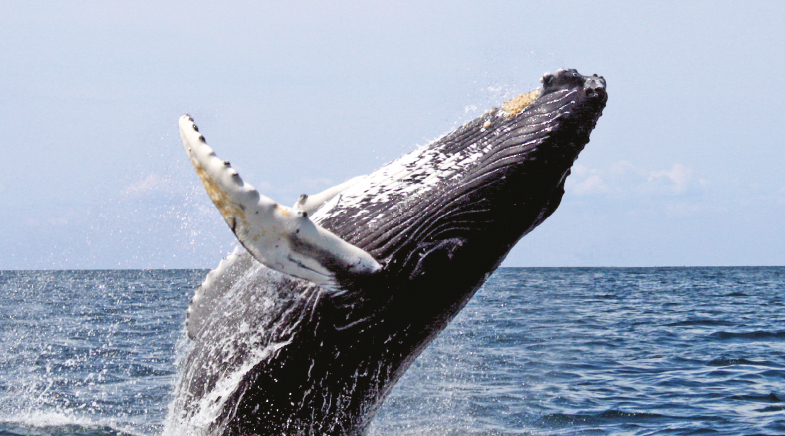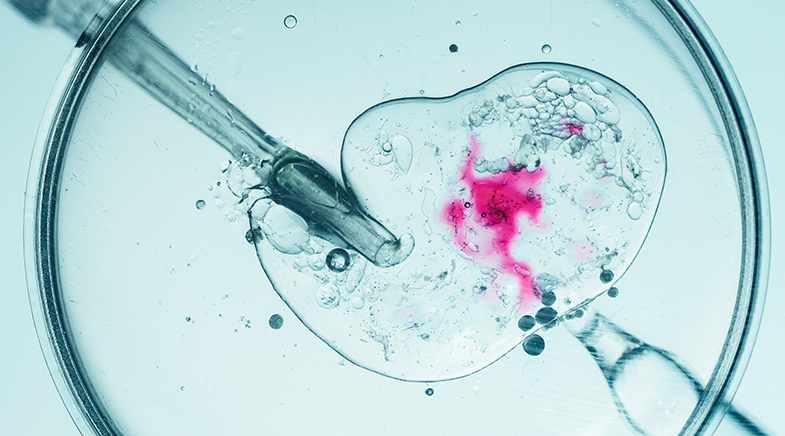Pollen power
-
- from Shaastra :: vol 03 issue 08 :: Sep 2024

The 'diamond of the natural world' helps map migrations, and assists in solving ancient riddles and modern crimes.
The painted lady (Vanessa cardui), a small butterfly with orange, black and white markings, is popular for its striking looks. In 2019, when unusually large swarms of these butterflies appeared in many parts of Europe, citizen scientists and entomologists were all aflutter. Gerard Talavera, who heads the PhyloMigration Lab at the Botanical Institute of Barcelona, has a special fascination for this butterfly because of its exceptional migration patterns. Talavera, who has a background in genetics, had earlier devised a system of metabarcoding pollen grains to study insect migration. Metabarcoding is a method of identifying short, variable gene regions in the DNA for taxonomic groupings. He deployed the tool to study the painted lady population explosion.
Talavera's team reached out to citizen scientists to collect butterflies. Over seven months, they captured 264 butterflies across 10 countries from Africa, Asia and Europe. The researchers then studied the pollen grains clinging to the butterflies. Insects give a free ride to pollen grains, which they collect and deposit while feeding on flowers. Through metabarcoding, the researchers identified 398 plants on which the butterflies had fed. Mapping the distribution of the plants, they have now chalked out a probabilistic migratory path for the butterflies (bit.ly/butterfly-migration).
"The adult butterfly lives for around three to five weeks, so these migrations occur over generations," says Talavera. His team's studies showed that the butterflies collected in eastern Europe in the spring of 2019 had pollen from plants that grow in West Asia and northern Africa. Similarly, he adds, butterflies collected in Russia and Scandinavia showed pollen from plants in southern Europe. The scientists traced the demographic explosion to favourable climate in the Saharan-Arabian belt in 2018, which had led to lush vegetative growth. Talavera also used the barcoding technique to track the transoceanic migration of the painted lady from Africa to South America. "With pollen metabarcoding, we have created a tool that can be used by researchers to map several other animal migrations," says Talavera.

For most people, pollen is synonymous with allergies, which are caused by proteins on its surface. For researchers like Talavera, however, the pollen grain has become a versatile scientific tool. It doesn't just map current migrations but can also help study migrations from millennia ago. It can help solve ancient riddles and modern crimes, and is emerging as a useful biomaterial.
THE 'DIAMOND' DUST
The pollen shell comprises two walls – the outer 'exine' and inner 'intine' – which encompass the male gametes and associated reproductive material. The intine is made of cellulose and pectin. The exine is made of sporopollenin, a complex hydrocarbon, often called the 'diamond of the natural world' for its resistive properties that can withstand extreme pH and temperature ranges. The molecular structure of sporopollenin was decoded just a few years ago (bit.ly/sporopollenin-structure) and there are still several gaps in the understanding of the structure.
Pollen is synonymous with allergies but it has become a versatile scientific tool for some researchers.
In higher plants, the pollen grain is the carrier of the male genetic material, which, when deposited on the flower's stigma, facilitates the transfer of the male gametes into the ovule. In lower plants like algae, moss and ferns, the same material forms the spore, which is a miniature encapsulation of the plant itself, and a form of asexual reproduction. Pollen and spores together are studied under a relatively new branch of science called palynology.
Ratan Kar is a palynologist at the Birbal Sahni Institute of Palaeosciences, Lucknow. He specialises in the Himalayan region's 'palaeo lakes' – ancient lakes that are now just flattened landscapes – and digs samples from the sediments. Pollen is the most abundant fossil in any sample. "On a small piece of rock, you might find the fossil of a single leaf. But that sample can yield tens of types of pollens, and thousands of grains of each type," says Kar. Back in the lab, he macerates the samples, treats them with acid washes to remove sediments, and separates the fossilised pollen grains. He then dates them through carbon dating and studies them under the microscope.
Kar focuses on the Quaternary Period, the current geological period that ranges from 2.58 million years ago to the present. He understands the climate stresses and changes during this time by studying the distribution and abundance of pollen grains. In tune with present-day observations, an abundance of grass and shrub pollen in the sediment indicates a dry and cold climate, and abundant tree pollen indicates a warmer and wetter climate.
His team analysed the anthropogenic impact in Kedarnath, and discovered that till around 4,000 years ago, the study site – today treeless – was forested with oak and Himalayan birch. Except for pine trees, which pollinate by wind, most pollen grains fall within 200m of the mother plant. He deduced that these grains represent trees that once stood there. In a span of the next few hundred years, the forests were totally gone. "My theory is that humans began visiting the place in large numbers for some reason. They burnt down trees to such an extent that they could not regenerate," says Kar. As validation of his theory, he points to the presence of coprolites (fossilised dung) of grazing animals, which became abundant as the tree pollen thinned out.

Kar and colleague Mohammad Firoze Quamar also reconstructed palaeo-agricultural maps of the country based on evidence from pollen grains. Their paper discusses the origin of agriculture, its changing intensity and also the impact of changing climate on agriculture. For instance, between 1350 and 1800 CE, the evidence of more drought-resistant millets and pulses indicates a warmer and drier climate (bit.ly/holocene-farming). "We need more data. Palynology is just 100 years old, and much of the detailed research work has only happened in the last two decades," says Kar.
Stripped of its allergy-inducing proteins and contents, the pollen grain can be used as a natural vehicle to transport oral vaccines and drugs to the body.
Bandana Samant, Professor at Central University of Punjab, Bathinda, has been studying pollen for all of these two decades. She works mostly in the Deccan region, where she studies the climate when the Indian continental plate was still moving towards the Eurasian plate millions of years ago. It was a time when volcanic activity was eliminating species after species. Samant looks for sediments of the intertrappean periods, breaks in time when volcanic activity ceased (the eruptions continued over several million years) and when plant life re-emerged. "We have climate records for only the last 100 years. Before that, the records are in the Earth's sediments, and palynology is the window to ancient climates," she says.
Pollen can also indicate the presence of coal and petroleum deposits. For instance, an abundance of phytoplankton sporopollenin, combined with fossils of single-celled dinoflagellates, is an indicator of petroleum deposits, says Samant, who is the co-editor of the book Applications of Palynology in Stratigraphy and Climate Studies.
VERSATILE BIOMATERIAL
Over the last decade, pollen has been explored as a versatile biomaterial. Once stripped of its allergy-inducing proteins, the hollow shell can be used as a natural vehicle to transport oral vaccines and drugs to the body, replacing synthetic microcapsules. The first experiment using pollen as a carrier for insulin was done in 1994, but the interest has picked up only over the past few years. Saurabh Srivastava, Associate Professor at Hyderabad's National Institute of Pharmaceutical Education and Research, says that among biomaterials, "sporopollenin shells stand out for their high mechanical strength and the high surface-to-volume ratio… The shells can be easily customised and allow for surface modification to facilitate treatments like immunotherapy. Also, they are abundantly available." In a recent paper (bit.ly/pollen-cancer), he discusses the benefits of using sporopollenin as a micro-carrier and scaffold in cancer therapy. He notes that phytoconstituents like flavonoids in pollen could help in cancer therapy.
Shoba Narayan, Associate Professor of medical bio-nanotechnology at the Chettinad Academy of Research and Education, demonstrates the ease with which macromolecules can be loaded onto sporopollenin hollows. The lotus flowers on display in temple streets caught her attention. So instead of resorting to commercially available sporopollenin, her team took armloads of lotus to the lab and extracted the pollen. They immersed these shells in a concentrated solution of anthocyanin, a nutraceutical and pH indicator, and let adsorption do its work (bit.ly/pollen-lotus).

In another research, a team from the U.K. and Canada used clubmoss spores as a suit of armour to protect marinomycins. These new antibiotics, sourced from marine microbes, are effective in treating antibiotic-resistant infections and in cancer therapy. However, they degrade rapidly when exposed to light. The researchers showed that encapsulating them in the pollen shell provided UV protection and kept them stable (bit.ly/marinomycin-armour).
Elsewhere, researchers have shown them as effective carriers for agricultural pesticides (bit.ly/pollen-pesticide) and in the cosmetic industry. Although the sporopollenin polymer is tough and resistant, it is soft to touch, and does not abrade. Just a light pressure from the fingers releases the cosmetic from its pore, potentially replacing microplastic beads used for the purpose, notes Sporomex, an R&D company started at the University of Hull, U.K., to develop microcapsule delivery systems. The exine itself has sunscreen-like properties, making sporopollenin doubly useful in this regard.
Pollen as a biomaterial has not gone into production on a large scale yet, partly owing to the cost of purification for removing allergens. Purification also affects the elasticity of its pore.
However, pollen as a biomaterial has not gone into production on a large scale yet. One reason, says Marta Roldo, is the high cost of purification for removing allergens. Roldo, Associate Professor in Biomaterials at the University of Portsmouth, U.K., has used sporopollenin as a bio-template for producing calcium phosphate minerals (for use in bone repair and regeneration). "If a calcination step is introduced post-biomaterial production, the purification step is not necessary," she says. Srivastava notes another drawback — the elasticity of the pore gets affected during the purification process, leading to potential leakage of drugs. He suggests adding controlled release agents to the drug or aperture.
CATALYST AND COSMETIC
Three years ago, nanoscientist couple Jayamurugan Govindasamy and Gowri Jayamurugan got interested in sporopollenin after reading scientific literature on it; now they have used it to create nano materials like copper nanostars. The two have also teamed up with Jithin John Varghese of the Indian Institute of Technology Madras to use sporopollenin as a catalyst for converting biomass into smaller molecules like furfural, which has various industrial uses (bit.ly/pollen-catalyst). "When treated with phosphoric acid (to remove gametes and other material), sporopollenin forms functional mono- and di-phosphate, which catalyse the degradation of the biomass in the presence of just water," explains Jayamurugan, Professor at the Institute of Nano Science and Technology, Mohali.
Gowri took the entrepreneur route with Gowriz Skincare, a start-up that uses sporopollenin in cosmetics. "Most commercial sunscreens use three ultraviolet filters to cover the entire range of 280 to 420 nm wavelength of light. These filters do not last long enough and cause patchiness as they break down," she says. Sporopollenin is already known for its sunscreening ability; she worked on functionalising it till she got a broad-spectrum filter. She has applied for a patent. She has also created an anti-wrinkle formulation with sporopollenin.
It is time to put the potential of the pollen to commercial use.
THE CRIMEBUSTER

Pollen is everywhere – in the air and in the soil. People and objects collect pollen grains on their clothes and surfaces, carrying a veritable route map of their travel, as the local flora changes. Invisible to the naked eye and sized about 25-40 microns, pollen grains are so tenacious that they may cling to hair and clothes even after several rounds of washing. Detectives use the presence of pollen to map the movement of a suspect or a victim. While the first crime to be solved with pollen evidence was around 50 years ago, the methods of collecting this evidence have become more sophisticated over time. In 2023, a murder in Argentina was solved by associating pollen grains, found on the body of the victim, with those found on the suspect (bit.ly/pollen-murder).

The U.S. Customs and Border Protection routinely uses the expertise of forensic palynologists to map the routes that drug consignments have travelled through. But the potential of forensic palynology remains underutilised due to a shortage of experts in the field.
Have a
story idea?
Tell us.
Do you have a recent research paper or an idea for a science/technology-themed article that you'd like to tell us about?
GET IN TOUCH














